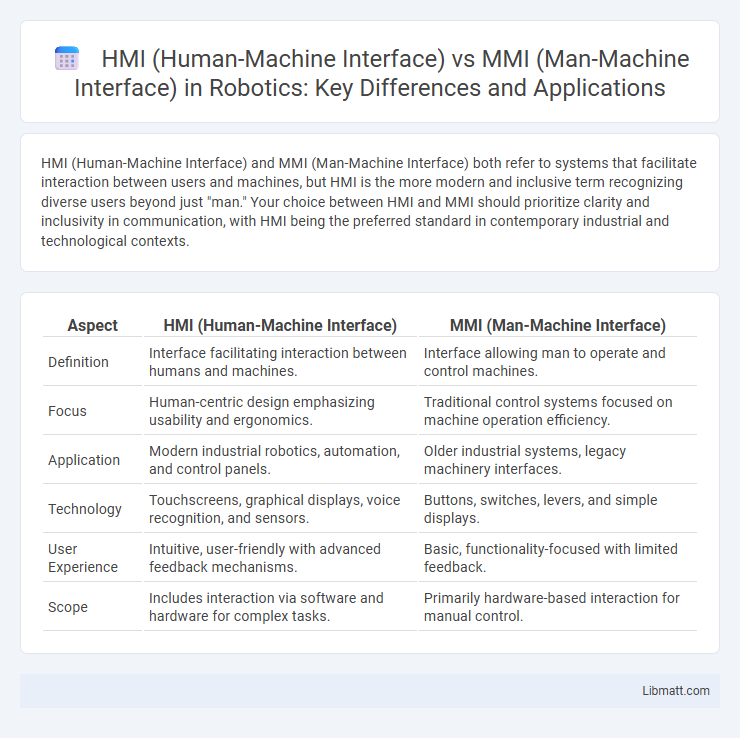HMI (Human-Machine Interface) and MMI (Man-Machine Interface) both refer to systems that facilitate interaction between users and machines, but HMI is the more modern and inclusive term recognizing diverse users beyond just "man." Your choice between HMI and MMI should prioritize clarity and inclusivity in communication, with HMI being the preferred standard in contemporary industrial and technological contexts.
Table of Comparison
| Aspect | HMI (Human-Machine Interface) | MMI (Man-Machine Interface) |
|---|---|---|
| Definition | Interface facilitating interaction between humans and machines. | Interface allowing man to operate and control machines. |
| Focus | Human-centric design emphasizing usability and ergonomics. | Traditional control systems focused on machine operation efficiency. |
| Application | Modern industrial robotics, automation, and control panels. | Older industrial systems, legacy machinery interfaces. |
| Technology | Touchscreens, graphical displays, voice recognition, and sensors. | Buttons, switches, levers, and simple displays. |
| User Experience | Intuitive, user-friendly with advanced feedback mechanisms. | Basic, functionality-focused with limited feedback. |
| Scope | Includes interaction via software and hardware for complex tasks. | Primarily hardware-based interaction for manual control. |
Introduction to HMI and MMI
Human-Machine Interface (HMI) and Man-Machine Interface (MMI) both refer to systems enabling interaction between humans and machines, emphasizing user-friendly communication and control. HMI typically highlights advanced digital interfaces used in industries like manufacturing, automation, and robotics, incorporating touchscreens, graphical displays, and real-time data monitoring. MMI, a term more common in earlier technology contexts, broadly describes mechanical or electronic interfaces facilitating user commands and feedback, underpinning modern HMI developments.
Defining HMI: Human-Machine Interface
Human-Machine Interface (HMI) refers to the user interface and interaction platform that connects an operator to a machine, enabling real-time control and feedback within industrial systems, automation, and computing environments. HMI focuses on ergonomic design, intuitive controls, and graphical displays to enhance operator efficiency, system monitoring, and decision-making accuracy. It distinguishes itself from Man-Machine Interface (MMI) by emphasizing human factors engineering and seamless digital communication between humans and automated machinery.
Defining MMI: Man-Machine Interface
The Man-Machine Interface (MMI) defines the interaction point where humans communicate and control machines using input and output devices, encompassing hardware like keyboards, touchscreens, and sensors. MMI traditionally emphasizes the physical and mechanical interaction between operators and machinery, guiding user commands and machine feedback in industrial and manufacturing settings. Understanding your MMI setup is crucial for optimizing control efficiency and reducing errors in complex systems.
Key Terminology Differences: HMI vs MMI
HMI (Human-Machine Interface) emphasizes the interaction between a human operator and machines using digital displays, touchscreens, and control panels, whereas MMI (Man-Machine Interface) is an older term referring broadly to direct physical interactions with machines. The terminology shift from MMI to HMI reflects a modern focus on user-friendly, intuitive interfaces designed for diverse human users rather than just operators or technicians. Understanding these differences helps you select the right interface technology for efficient and effective machine control in your operations.
Historical Evolution of HMI and MMI
The historical evolution of HMI (Human-Machine Interface) reflects a shift from early MMI (Man-Machine Interface) designs, which were limited by gendered terminology and less intuitive interaction methods, to more user-centered HMI systems emphasizing accessibility and advanced usability. Early MMI systems primarily focused on mechanical and electrical controls, evolving into sophisticated HMI technologies integrating touchscreens, voice recognition, and gesture control to enhance human interaction with machines. Your understanding of this transition highlights the growing importance of ergonomics and inclusivity in interface design, which today prioritizes seamless and efficient communication between humans and automated systems.
Technological Components in HMI and MMI
HMI (Human-machine interface) primarily incorporates advanced technological components such as touchscreens, graphical user interfaces (GUIs), sensors, and integrated software systems designed for intuitive interaction. MMI (Man-machine interface) similarly includes hardware like buttons, knobs, display panels, and basic control units but often emphasizes physical interaction over digital interfaces. The evolution of HMI reflects a shift towards more sophisticated, user-centric technologies, while MMI components focus on direct manipulation and feedback in industrial and mechanical environments.
Applications: Where HMI and MMI are Used
HMI (Human-Machine Interface) technology is commonly used in industrial automation, manufacturing processes, and smart home systems to enable seamless interaction between humans and machines. MMI (Man-Machine Interface) is often applied in military and aerospace sectors, focusing on cockpit controls and defense system operations to ensure efficient man-machine coordination. Your choice between HMI and MMI depends on the specific application environment and the level of user interaction required.
User Experience: HMI vs MMI
User experience in HMI (Human-Machine Interface) typically emphasizes intuitive interaction through touchscreens, voice commands, and graphical displays, enhancing ease of use and accessibility. MMI (Man-Machine Interface), an earlier term, often involves more mechanical controls and less sophisticated feedback, leading to a less seamless user interaction. Your engagement improves significantly with HMI designs that prioritize ergonomics and real-time responsiveness compared to traditional MMI systems.
Industry Standards and Trends
HMI (Human-Machine Interface) and MMI (Man-Machine Interface) both facilitate interaction between operators and machines, but HMI is more widely adopted in current industrial standards due to its emphasis on user-centered design and enhanced digital integration. Industry trends favor HMI platforms that incorporate advanced visualization, touchscreen technology, and IoT connectivity to improve efficiency and real-time monitoring in manufacturing environments. Standards such as IEC 62443 and ISO 9241 increasingly influence HMI development, promoting cybersecurity, usability, and interoperability across industrial automation systems.
The Future of Human-Centric Interfaces
Human-machine interface (HMI) and man-machine interface (MMI) both center on enhancing user interaction with technology, but HMI increasingly emphasizes intuitive, adaptive designs driven by artificial intelligence and machine learning to create more personalized experiences. The future of human-centric interfaces points toward seamless integration of natural language processing, gesture recognition, and augmented reality to foster immersive and accessible user environments. Advances in sensor technology and real-time data analytics will further enable these interfaces to anticipate user needs, improving efficiency and safety across industries.
HMI (Human-machine interface) vs MMI (Man-machine interface) Infographic

 libmatt.com
libmatt.com